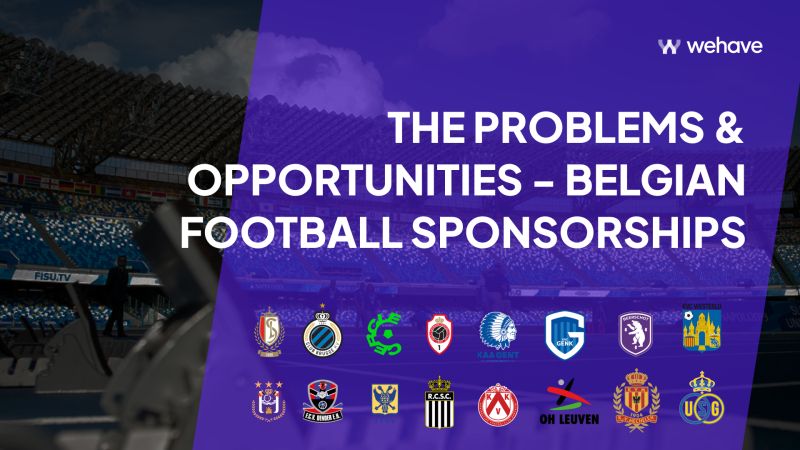Date
Oct 18, 2024
Writer
Oliver Wolfs
The Current State of Sponsorships
In today’s digital-first world, traditional models of sponsorships are under increasing pressure to demonstrate tangible value and return on investment. Sponsors expect more than just general visibility and awareness; they seek to measure KPIs and target their marketing efforts with precision.
Amid these challenges, data collaboration emerges not just as a solution but as a revolutionary approach to reinvent sponsorship engagements. At the heart of this innovation is the application of data clean rooms. Although initially complex, this concept offers a clear path to maximizing sponsorship potential. Let’s explore this technology by examining some examples of its application and benefits.
The Problem: Measuring Sponsorship ROI & Increasing Conversion
Consider a common scenario in sports sponsorships today: a brand sponsors a major football club, aiming to increase brand awareness among the club's fans. Traditional metrics like impressions or general engagement rates provide a broad picture but fail to capture the depth needed to understand the true impact Are aware. fans becoming a customer easier? How many fans actually converted into customers as a result of the sponsorship?
Moreover, how can we transition from awareness and visibility to converting fans into customers? How can this brand and the football club share insights and target audiences without violating privacy norms?
The Solution: The Wehave Data Clean Room For Sponsorship
This is where data clean rooms come into play. A data clean room is a secure environment that allows for the pooling and analysis of data from multiple sources—such as the football club and the sponsoring brand—without exposing individual data points or sharing any underlying data. All data is anonymized and standardized automatically.
This technology enables both parties to merge their datasets in a controlled space, analyze the combined data, and extract actionable insights or target audiences—all while maintaining the highest standards of data privacy, security, and full control over their own data. Outside of insights and analytics, you can also create segments for loyalty or acquisition campaigns to target in digital advertising or owned media!
A Concrete Example: Football Club Sponsorship
Imagine a football club that has detailed data on its fan base. The sponsoring brand, on the other hand, has data on its purchases, both online and in physical stores, along with engagement metrics from its marketing campaigns. By pooling their data in a clean room, they can answer critical questions:
Measuring ROI and conversion by analyzing customer overlap before, during, and after the season to gauge conversion and the real ROI.
Identifying which specific aspects of the sponsorship (e.g., digital ads, event signage, promotional events) correlated most strongly with increased brand engagement or sales. This insight allows the brand and the sports league to fine-tune future sponsorships, focusing on the most effective elements.
Targeting fans with online activation campaigns. While awareness and visibility remain crucial, targeted activation campaigns aimed at fans, like offering a shirt of their favorite team, can significantly lower customer acquisition costs (CAC) by 60%. Small efforts lead to big results!

Barca x spotify sponsorship deal
Data in the FC Barcelona x Spotify Sponsorship Deal
An example is the FC Barcelona x Spotify sponsorship deal, where Spotify expressed interest in accessing Barcelona's data and indicated a willingness to pay almost double if they had access. Unfortunately, Barcelona was not prepared with the data. As clubs become more technologically advanced, collecting data becomes crucial. Since customer data cannot be freely shared, a specialized data clean room solution for sponsorships is essential.
The Outcome
This collaboration, facilitated by a data clean room, not only provides the sponsoring brand with a clear, quantifiable return on investment but also strengthens the relationship between the brand and the football club. It enables both parties to make informed decisions based on shared insights, leading to more effective and targeted sponsorship campaigns that resonate with the intended audience, thereby enhancing fan experiences and driving higher engagement and sales. Test, measure, iterate, and win!
The Sponsorship Flywheel
More value for the sponsors leads to more and better sponsorship deals, which in turn lead to better performance, fan experience, and data, creating more value for the sponsors.
Conclusion
As we look to the future, the possibilities for innovation in sponsorship deals through data collaboration are only beginning to unfold. This approach offers a promising path for those willing to explore data-driven strategies, ensuring that sponsorships not only achieve but exceed, their potential for impact and engagement.
In this new era, the question for sponsors is not if they should embrace data collaboration, but how quickly they can adapt to its opportunities. The journey toward more meaningful and effective sponsorships starts with a willingness to explore the untapped potential within data.
Meet Wehave - Your Key to Data-Driven Sponsorships
Wehave emerges as your indispensable partner in this journey, offering a comprehensive suite of services designed to harness the power of data collaboration in sponsorships. Embarking on this journey with Wehave means not just keeping pace with the future of sponsorships but leading it.








